Can Salt Treat Wood Be Used For A Raised Garden Box
Last updated on March 19th, 2021
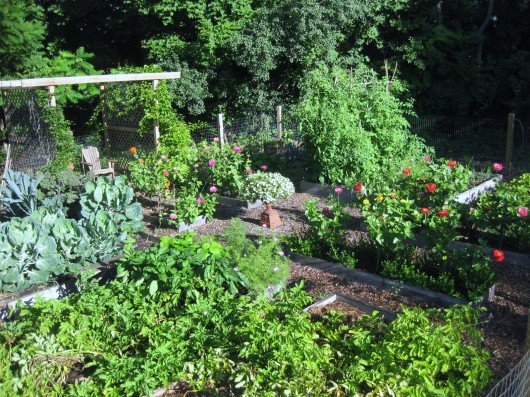 IF THE IDEA of growing a year's supply of healthy, organic vegetables and herbs appeals to you, but the thought of digging through compacted, rocky soil does not, consider growing your crops as I do: in raised beds. You'd be amazed at how many benefits there are to gardening "on higher ground," and how easily beds can be constructed.
IF THE IDEA of growing a year's supply of healthy, organic vegetables and herbs appeals to you, but the thought of digging through compacted, rocky soil does not, consider growing your crops as I do: in raised beds. You'd be amazed at how many benefits there are to gardening "on higher ground," and how easily beds can be constructed.
You can build a raised bed from almost any material you like, as long as it is sturdy and does not contain harmful chemicals. Do not use pressure-treated lumber (including railroad ties) because it contains toxins that can leach into the soil. Bricks, cement blocks, and untreated lumber are all suitable for framing.
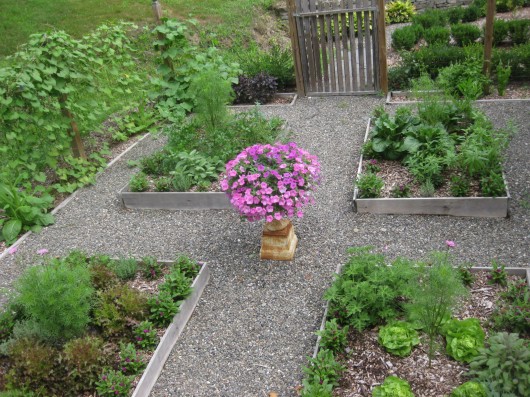 Even cheap pine boards can be used to frame a bed. Pine, however, is not rot-resistant, so you'll have to replace it after 5 years or so. The boards will last longer if you first paint them with raw, not boiled, linseed oil. I used untreated 1-by-10 inch pine for the beds in my Herb Garden (above). After one season the wood turned from boring beige to graceful gray. I paved the paths between beds with pea gravel, and then enclosed the entire garden with wire mesh attached to pressure-treated posts.
Even cheap pine boards can be used to frame a bed. Pine, however, is not rot-resistant, so you'll have to replace it after 5 years or so. The boards will last longer if you first paint them with raw, not boiled, linseed oil. I used untreated 1-by-10 inch pine for the beds in my Herb Garden (above). After one season the wood turned from boring beige to graceful gray. I paved the paths between beds with pea gravel, and then enclosed the entire garden with wire mesh attached to pressure-treated posts.
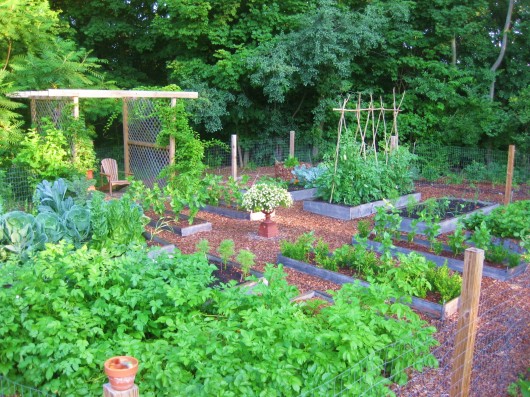 For my kitchen garden, I built eight 4-by-8 foot beds from inexpensive, rough-hewn hemlock. Hemlock, like cedar, oak and redwood (these last two are pricey) is naturally rot-resistant. The boards of these beds are 12-inches high and 2-inches thick. Running perpendicular to the hemlock-enclosed beds are four 2-by-8 foot beds framed with 1-by-10 inch pine. Paths here are paved with shredded wood chips, and the garden is protected from woodchucks, rabbits, and deer by wire-mesh fencing.
For my kitchen garden, I built eight 4-by-8 foot beds from inexpensive, rough-hewn hemlock. Hemlock, like cedar, oak and redwood (these last two are pricey) is naturally rot-resistant. The boards of these beds are 12-inches high and 2-inches thick. Running perpendicular to the hemlock-enclosed beds are four 2-by-8 foot beds framed with 1-by-10 inch pine. Paths here are paved with shredded wood chips, and the garden is protected from woodchucks, rabbits, and deer by wire-mesh fencing.
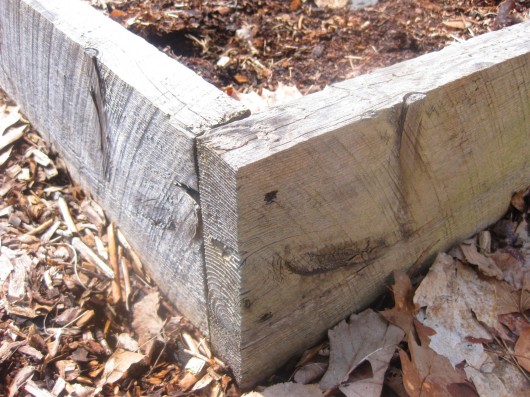 As for building a timber-framed bed, no carpentry job could be easier. Simply join the corners together with galvanized nails or screws. I used 1 ½-inch nails for my thin pine-framed beds, and 4-inch screws for my thicker hemlock models. Although corner posts are commonly used for raised beds, I have not found them necessary.
As for building a timber-framed bed, no carpentry job could be easier. Simply join the corners together with galvanized nails or screws. I used 1 ½-inch nails for my thin pine-framed beds, and 4-inch screws for my thicker hemlock models. Although corner posts are commonly used for raised beds, I have not found them necessary.
Before filling a frame with soil, it is imperative to line the bottom of the bed with either corrugated cardboard or several thicknesses of newspaper. This material will smother any weeds or grass that would otherwise grow up through the raised bed and impede your perfect planting plan.
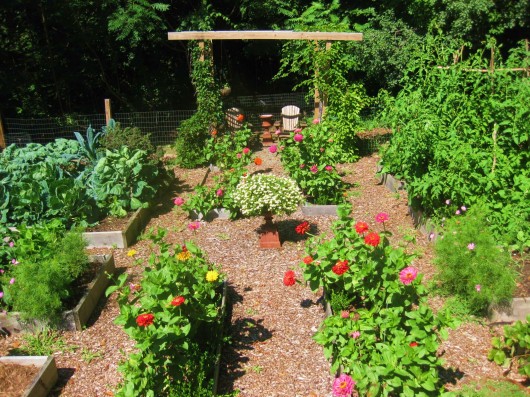 Of course, flowers love raised beds as much as vegetables do. I usually plant zinnias in the long central beds of my kitchen garden; they attract the bees and butterflies necessary for pollinating my crops. They also provide beautiful bouquets for indoor enjoyment.
Of course, flowers love raised beds as much as vegetables do. I usually plant zinnias in the long central beds of my kitchen garden; they attract the bees and butterflies necessary for pollinating my crops. They also provide beautiful bouquets for indoor enjoyment.
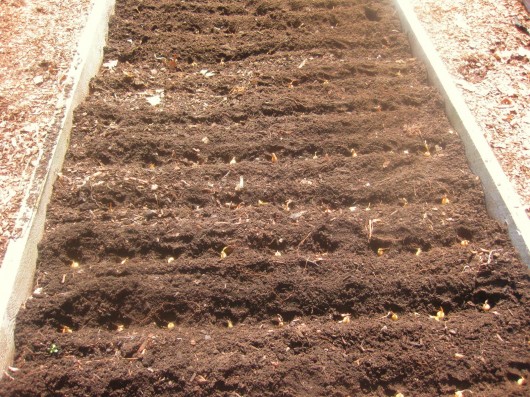 A raised bed lets you garden in perfect soil. By "perfect," I mean soil which is fertile, well-draining, and free of rocks and weeds. My own veggies flourish in equal parts top soil, composted manure, and sand. These components were mixed and delivered by a local farm. I've known other gardeners who fill their beds with packaged mixtures obtained from the garden center or hardware store.
A raised bed lets you garden in perfect soil. By "perfect," I mean soil which is fertile, well-draining, and free of rocks and weeds. My own veggies flourish in equal parts top soil, composted manure, and sand. These components were mixed and delivered by a local farm. I've known other gardeners who fill their beds with packaged mixtures obtained from the garden center or hardware store.
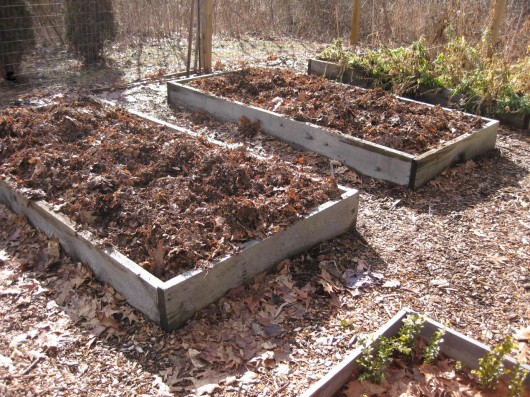 To insure ongoing fertility from year to year, and to avoid the need to purchase additional soil to refill the beds as settling occurs, I top my beds off each fall with shredded leaves. As the leaves decompose over winter, they add vital nutrients to the soil, and improve its water-retention.
To insure ongoing fertility from year to year, and to avoid the need to purchase additional soil to refill the beds as settling occurs, I top my beds off each fall with shredded leaves. As the leaves decompose over winter, they add vital nutrients to the soil, and improve its water-retention.
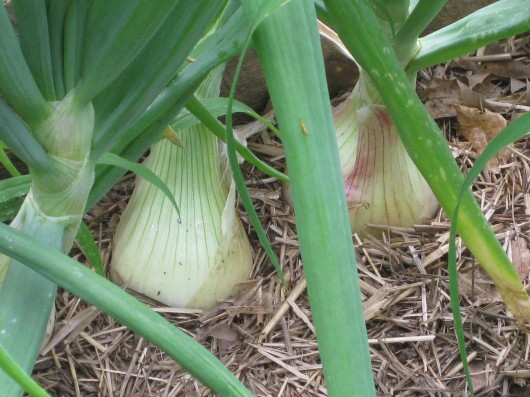 Soil in a raised bed does not become compacted. Why? Because it is never walked upon. Unencumbered by rocks or hard clumps of soil, root vegetables like carrots and parsnips grow straight and long. Beets, turnips and onions (that's my beloved 'Copra' above) grow into the beautiful globes depicted on their seed packets.
Soil in a raised bed does not become compacted. Why? Because it is never walked upon. Unencumbered by rocks or hard clumps of soil, root vegetables like carrots and parsnips grow straight and long. Beets, turnips and onions (that's my beloved 'Copra' above) grow into the beautiful globes depicted on their seed packets.
 If you suffer from a bad back, you will appreciate being able to plant and harvest your vegetables without bending deeply. In fact, if you build your beds high enough, you won't have to bend at all. If you limit your beds to 3 to 4 feet in width, you will not have to reach excessively, either.
If you suffer from a bad back, you will appreciate being able to plant and harvest your vegetables without bending deeply. In fact, if you build your beds high enough, you won't have to bend at all. If you limit your beds to 3 to 4 feet in width, you will not have to reach excessively, either.
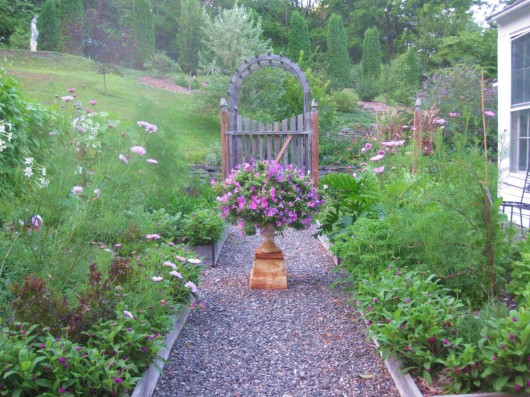 Because plants can be grown very close to each other in a raised bed, even a tiny yard can support a lavish edible garden. The four 6-by-4 foot beds in my small herb garden, pictured above, produce copious quantities of parsley, thyme, and other aromatics. I pick these herbs at the peak of their perfection, then freeze them for winter use.
Because plants can be grown very close to each other in a raised bed, even a tiny yard can support a lavish edible garden. The four 6-by-4 foot beds in my small herb garden, pictured above, produce copious quantities of parsley, thyme, and other aromatics. I pick these herbs at the peak of their perfection, then freeze them for winter use.
A raised bed vegetable garden has less weeding, less bending, and absolutely no tilling—there are really no negatives to this type of gardening. Well, none that I can think of, anyway. Let me know if you're a fan of gardening "on higher ground," too.
Don't miss anything at A Garden for the House…sign up for Kevin's weekly newsletter.
Related Posts:
From Wild Patch to Woodland Garden
From Hellish Hill to Serpentine Garden
What Would You Plant in Your "Subsistence Garden"?

Can Salt Treat Wood Be Used For A Raised Garden Box
Source: https://www.agardenforthehouse.com/creating-a-raised-bed-garden/
Posted by: raylichannoosee.blogspot.com

0 Response to "Can Salt Treat Wood Be Used For A Raised Garden Box"
Post a Comment